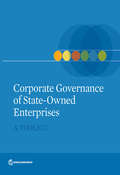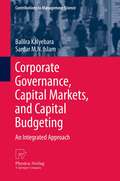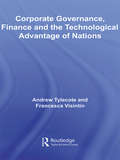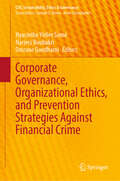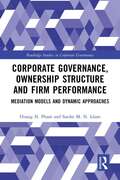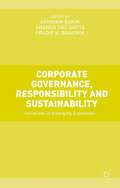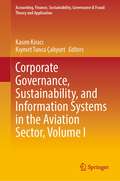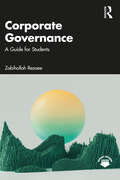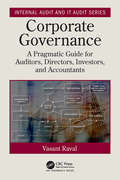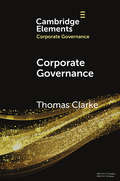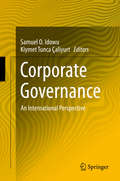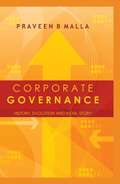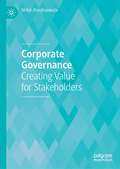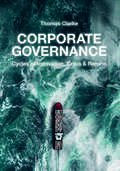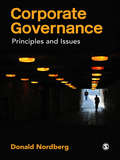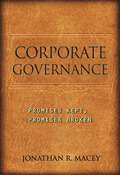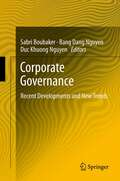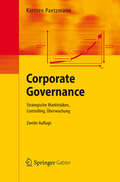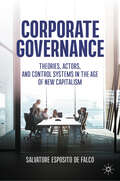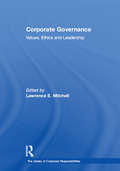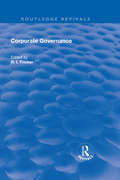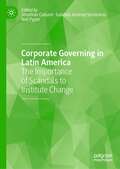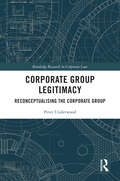- Table View
- List View
Corporate Governance of State-Owned Enterprises
by World Bank PublicationsThis Toolkit provides an overall framework with practical tools and information to help policymakers design and implement corporate governance reforms for state-owned enterprises. It covers the key elements of corporate governance, including legal and regulatory framework, state ownership arrangements, performance management systems, financial and fiscal discipline, boards of directors, transparency and disclosure, and protection of shareholders in mixed ownership companies. Experience shows that no one approach is universally applicable and the choice of measures depends on country and enterprise circumstances. The Toolkit thus provides a range of frameworks, concepts, case examples, checklists, and model documents that together aim to help government officials make the appropriate choices for their circumstances. The Toolkit concludes with guidance on managing the reform process, in particular how to prioritize and sequence reforms, build capacity, and engage with stakeholders.
Corporate Governance, Capital Markets, and Capital Budgeting: An Integrated Approach (Contributions to Management Science)
by Sardar M. Islam Baliira KalyebaraThe primary contribution of this book is to integrate the important disciplines which simultaneously impact the investment appraisal process. The book presents a study that develops a new approach to investment appraisal which uses a multiple objective linear programming (MOLP) model to integrate the selected disciplines which include capital markets, corporate governance and capital budgeting. The research covers two case studies, one in the e-commerce sector and another in the airline industry in which the above disciplines are integrated. Readers from the areas of corporate governance, regulation, and accounting would find the survey of different approaches and the new integrated optimization approach particularly useful.
Corporate Governance, Finance and the Technological Advantage of Nations (Routledge Studies in Global Competition)
by Andrew Tylecote Francesca VisintinWinner of the 2010 Myrdal Prize There is much debate regarding which countries’ economies have the best economic systems to encourage economic growth and technological change. This book is a major contribution to this discussion, connecting the fields of corporate governance and finance with the field of innovation and technology and analysing the ways in which countries’ systems of corporate governance affect firms’ ability to meet the technological challenges of different sectors. Tylecote and Visintin combine incisive analysis with empirical studies systems of corporate governance in the US, Europe, East Asia and China, demonstrating how these systems vary and how the demands on those who control and finance industry are changing. The authors argue that while certain types of system have worked for particular sectors, the technological revolution through which we are passing demands innovation in corporate governance and finance. Indeed, this book goes some way in challenging accepted views of best practise in corporate governance and finance, showing how structures and rules intended to advance ‘shareholder value’ may undermine it by inhibiting technological change. This book will be very interesting reading for students and researchers engaged with corporate governance and national business systems, as well as those interested in systems of innovation.
Corporate Governance, Organizational Ethics, and Prevention Strategies Against Financial Crime (CSR, Sustainability, Ethics & Governance)
by Narjess Boubakri Hyacinthe Yirlier Somé Omrane GuedhamiThis book examines how corporate ethics, social responsibility, and prevention strategies against financial crime may remedy shortcomings of corporate governance. Corporate governance structures and mechanisms may contribute to enhancing the value of integrity in organizational life. Nonetheless, executives and directors who emphasize a structural and procedural way of thinking often miss the point. Corporate governance structures and mechanisms can favor practices of integrity and righteousness. But those structures and mechanisms have deficiencies since they cannot allow the organization to avoid corporate deviancy and delinquency. The book describes how corporate governance and social responsibility reports and programs may allow executives and directors to deepen the meaning of corporate governance, as it is related to organizational culture. Furthermore, the volume discusses how corporate governance structures and mechanisms (including the board of directors and shareholder activism) might have a significant impact on the way integrity is safeguarded in an organization. The contributions shed light on methods to clarify and extend the implications of corporate governance while taking risk management strategies into account.
Corporate Governance, Ownership Structure and Firm Performance: Mediation Models and Dynamic Approaches (Routledge Studies in Corporate Governance)
by Sardar M. Islam Hoang N. PhamThe relationship between ownership structure and firm performance has been studied extensively in corporate finance and corporate governance literature. Nevertheless, the mediation (path) analysis to examine the issue can be adopted as a new approach to explain why and how ownership structure is related to firm performance and vice versa. This approach calls for full recognition of the roles of agency costs and corporate risk-taking as essential mediating variables in the bi-directional and mediated relationship between ownership structure and firm performance. Based on the agency theory, corporate risk management theory and accounting for the dynamic endogeneity in the ownership–performance relationship, this book develops two-mediator mediation models, including recursive and non-recursive mediation models, to investigate the ownership structure–firm performance relationship. It is demonstrated that agency costs and corporate risk-taking are the ‘missing links’ in the ownership structure–firm performance relationship. Hence, this book brings into attention the mediation and dynamic approach to this issue and enhances the knowledge of the mechanisms for improving firm’s financial performance. This book will be of interest to corporate finance, management and economics researchers and policy makers. Post-graduate research students in corporate governance and corporate finance will also find this book beneficial to the application of econometrics into multi-dimensional and complex issues of the firm, including ownership structure, agency problems, corporate risk management and financial performance.
Corporate Governance, Responsibility and Sustainability: Initiatives In Emerging Economies
by Arindam Banik Ananda Gupta Pradip BhaumikCorporate Governance, Responsibility and Sustainability investigates various dimensions of corporate governance issues in key emerging economies such as China, India, Brazil, South Africa and Russia. The book explores a number of issues in the areas of corporate governance framework, market discipline and building an efficient, competitive market.
Corporate Governance, Sustainability, and Information Systems in the Aviation Sector, Volume I (Accounting, Finance, Sustainability, Governance & Fraud: Theory and Application)
by Kıymet Tunca Çalıyurt Kasım KiracıThis book delves into corporate governance, sustainability, and information systems related to the aviation sector. Due to globalization and rise in cross-border business, the aviation sector has become an essential means of transport. However, the industry has tremendous impact on social, economic, and natural environments and carries significant risks. The book explores such issues plaguing the aviation sector under three key areas: CSR and sustainability, information systems and risk management, and corporate governance and accountability in the airline industry. The book concludes with an analysis of the impact of COVID-19 crisis on the industry and ways to respond and recover from the effects of the pandemic.
Corporate Governance: A Guide for Students
by Zabihollah RezaeeCorporate governance has become increasingly central to corporate reporting and management as businesses face growing pressure to address their responsibilities in sustainability and corporate accountability. The evolving focus on effective corporate governance has driven the introduction of new laws, regulations, standards, and best practices, reshaping its framework, principles, and functions. Business leaders and students must stay informed about these significant reforms and the associated accountabilities. This book offers a clear, accessible guide to the key regulations, laws, and best practices essential for robust governance and stakeholder protection. It covers the roles and responsibilities of all key players in corporate governance, including directors, management, auditors, accountants, legal counsel, and financial advisors. Taking a practical approach, the book explores topics such as financial markets, investor confidence, oversight, managerial, compliance, internal and external auditing, legal advisory functions, and performance reporting. It serves as a valuable resource for students and professionals seeking a comprehensive understanding of corporate governance responsibilities.Designed for both undergraduate and graduate levels, this book equips students with the knowledge and skills needed to become successful business leaders. It is an ideal reference for business colleges, accounting schools, and other corporate governance programs, with individual chapters adaptable for various accounting and business courses.
Corporate Governance: A Pragmatic Guide for Auditors, Directors, Investors, and Accountants (Internal Audit and IT Audit)
by Vasant RavalThis book facilitates a systematic comprehension of internal workings of corporate governance in practice. Facets of this multidisciplinary, constantly evolving field are discussed and interrelationships among them are explained to provide insights on how certain precepts come into play for various roles in governance. This book pragmatically explains and illustrates with a view to integrate. To keep the scope achievable, the emphasis is placed on the U.S.-based companies; where possible, differences in governance around the world are identified. Three rich sources of knowledge help shape the message of this book: existing paradigms, personal experience in governance, and research on issues and challenges of governance. Features: Permits a holistic view of the complex corporate governance landscape. Discusses and generously illustrates the practice of corporate governance. Aids understanding of issues and challenges of corporate governance. Identifies ways to advance the value of one’s role in corporate governance. Teaches how to avoid crucial mistakes that compromise the value of one’s contribution in the governance process. If you are a professional accountant, securities lawyer, economist, financial analyst, auditor, executive, entrepreneur, or an investor, you will find the book helpful in understanding the entire landscape of governance fairly quickly. Those already involved in the governance arena may find the book refreshing, and may use it to coach others. This book can serve as a reference book in any offering of a course at any academic level.
Corporate Governance: A Survey (Elements in Corporate Governance)
by Thomas ClarkeThe recognition of the profound impact of corporations on the economies and societies of all countries of the world has focused attention on the growing importance of corporate governance. There is an ongoing diversity of corporate governance systems, based on historical cultural and institutional differences that involve different approaches to the values and objectives of business activity. Sound corporate governance is universally recognised as essential to market integrity and efficiency, providing a vital underpinning for financial stability and economic growth. As the adequacy of the existing dominant paradigms of corporate governance are increasingly challenged, the search for coherent new paradigms is a vital task for corporate governance in the future.
Corporate Governance: An International Perspective (CSR, Sustainability, Ethics & Governance)
by Samuel O Idowu Kiymet Tunca ÇaliyurtThis book brings together a representative collection of perspectives on the way how corporate governance is being aligned with the social responsibility of an organization and the accountability of its management both in large corporations and in medium sized businesses. Examples are given from various industries and branches as well as from different countries and regions across the globe. All examples are commented and explained in detail. Written by a group of selected academic teachers this book is suitable for adoption as a resource for a case driven approach to teaching "Corporate Governance" courses at an upper undergraduate or graduate level.
Corporate Governance: Concept, Evolution and India Story
by Praveen B. MallaWith the increasing awareness that mere economic and production-based explanations do not adequately describe the motivations for governance, researchers have focused on the behavioral side of the firm performance to justify the economic rationale of their typical behaviours. This book describes the concept of corporate governance, its emergence and the contemporary thinking around it. With emphasis on "conflicts of interests" assumed to be related to the theory of separation of ownership and control, the book delves into topics such as insider trading, excessive executive compensation, managerial, expropriation of shareholders’ wealth, false reporting, accounting non-disclosures and self dealing.
Corporate Governance: Creating Value for Stakeholders
by Shital JhunjhunwalaThe book covers the broad area of Corporate Governance (CG) and its constituents. It includes new and contemporary topics such as CG in family-controlled businesses, governance of multinational corporations, related party transactions and impact investing. It is a blend of theory and practice, and presents cases old and new, from Maxwell to Tata Sons, from both the western and eastern hemisphere to facilitate the understanding of CG issues. The book brings together governance frameworks of different countries in one place. For instance, when ‘appointment of auditors’ is discussed the UK code, US laws, EU Audit legislation 2016 and Indian rules are covered. It includes latest and novel regulations such as CSR in India.
Corporate Governance: Cycles of Innovation, Crisis and Reform
by Thomas ClarkeThis critical work explores the central dynamic of industrial capitalism – the cycle of brilliant innovation, catastrophic crisis, and the painful process of corporate governance reform. Coverage includes cycles of crisis and regulation, financial bubbles, including the global financial crisis, and digital disruption. Finally, the current crisis of industry induced climate change that now imperils the world is considered. Corporate Governance: Cycles of Innovation, Crisis and Reform is essential reading for final year undergraduate and postgraduate students of Corporate Governance, International Business and Business and Management Studies. Thomas Clarke is Emeritus Professor of Management at the University of Technology, Sydney. He is a Fellow of the Royal Society of Arts (FRSA) and an international corporate governance expert.
Corporate Governance: Cycles of Innovation, Crisis and Reform
by Thomas ClarkeThis critical work explores the central dynamic of industrial capitalism – the cycle of brilliant innovation, catastrophic crisis, and the painful process of corporate governance reform. Coverage includes cycles of crisis and regulation, financial bubbles, including the global financial crisis, and digital disruption. Finally, the current crisis of industry induced climate change that now imperils the world is considered. Corporate Governance: Cycles of Innovation, Crisis and Reform is essential reading for final year undergraduate and postgraduate students of Corporate Governance, International Business and Business and Management Studies. Thomas Clarke is Emeritus Professor of Management at the University of Technology, Sydney. He is a Fellow of the Royal Society of Arts (FRSA) and an international corporate governance expert.
Corporate Governance: Principles and Issues
by Mr Donald NordbergOffering a fresh look at the commonly accepted view of what constitutes good governance, Donald Nordberg explores the contexts of board decisions and draws upon his academic research and years of business and financial journalism in Europe, North America and Asia to provide a distinctive and pertinent contribution to the literature on corporate governance. The book:<P> - Features 21 detailed case studies, drawn from international examples, to prompt discussion and analysis<P> - Provides topical, up-to-date examples and evidence<P> - Gives attention to the important question "What next for Corporate Governance?"<P> Supporting features include: Case Study questions; "Agenda Point" boxes to provide further analysis and consideration on topical issues; Further readings; Companion Website, featuring online resources.<P> Visit the Companion Website at www.sagepub.co.uk/nordberg
Corporate Governance: Promises Kept, Promises Broken
by Jonathan R. MaceyEven in the wake of the biggest financial crash of the postwar era, the United States continues to rely on Securities and Exchange Commission oversight and the Sarbanes-Oxley Act, which set tougher rules for boards, management, and public accounting firms to protect the interests of shareholders. Such reliance is badly misplaced. In Corporate Governance, Jonathan Macey argues that less government regulation--not more--is what's needed to ensure that managers of public companies keep their promises to investors. Macey tells how heightened government oversight has put a stranglehold on what is the best protection against malfeasance by self-serving management: the market itself. Corporate governance, he shows, is about keeping promises to shareholders; failure to do so results in diminished investor confidence, which leads to capital flight and other dire economic consequences. Macey explains the relationship between corporate governance and the various market and nonmarket institutions and mechanisms used to control public corporations; he discusses how nonmarket corporate governance devices such as boards and whistle-blowers are highly susceptible to being co-opted by management and are generally guided more by self-interest and personal greed than by investor interests. In contrast, market-driven mechanisms such as trading and takeovers represent more reliable solutions to the problem of corporate governance. Inefficient regulations are increasingly hampering these important and truly effective corporate controls. Macey examines a variety of possible means of corporate governance, including shareholder voting, hedge funds, and private equity funds. Corporate Governance reveals why the market is the best guardian of shareholder interests.
Corporate Governance: Recent Developments and New Trends (CSR, Sustainability, Ethics & Governance)
by Duc Khuong Nguyen Bang Dang Nguyen Sabri BoubakerThe current crisis has rocked the financial system worldwide and has cast doubt on the effectiveness of the existing regulatory regime. Thousands of firms have gone bankrupt and many financial institutions were bailed out by governments. The effects of the crisis have shaken emerging and developing markets alike and have not spared neither small nor large businesses. Many scholars and practitioners attribute the roots of the crisis to failures and weaknesses in the way corporate governance has been practiced since the mid-1990s. Lax board oversight of top management, short-termism and self-interested behavior have been fingered as the culprits behind recent financial turmoil. This book highlights the recent developments and new trends in corporate governance. The eighteen chapters, written by leading academics and experts, can assist corporate executives, governance bodies, investors, market regulators, and policymakers in having a global picture of major corporate governance issues. This book highlights the recent developments and new trends in corporate governance. The eighteen chapters, written by leading academics and experts, can assist corporate executives, governance bodies, investors, market regulators, and policymakers in having a global picture of major corporate governance issues.
Corporate Governance: Strategische Marktrisiken, Controlling, Überwachung
by Karsten PaetzmannSeit den 1990er Jahren werden weltweit Standards zur Verbesserung der Unternehmensführung diskutiert und in Empfehlungen oder Rechtsnormen gegossen. Ziel der Corporate Governance ist es, die Rationalität der Unternehmensführung zu erhöhen und insbesondere die Erkennung und Handhabung von Risiken zu verbessern. Anhand von Fallstudien zeigt der Autor, dass die Risiken des Marktumfeldes zwar eine herausragende Rolle spielen, dass die Unternehmensführung aber der Dualität des Marktumfeldes, also den Chancen und Risiken, Rechnung zu tragen hat.
Corporate Governance: Theories, Actors, and Control Systems in the Age of New Capitalism
by Salvatore Esposito De FalcoIn an era marked by financial scandals, corporate crises, and rapid technological advancements, this textbook equips readers with the knowledge and tools necessary to navigate the complexities of corporate governance effectively. Divided in three thematic sections, it offers a thorough examination of corporate governance theories, key actors and the systems of control essential in the current era of 'New Capitalism'. The chapters go beyond theoretical concepts, featuring numerous practical case studies drawn from real-world scenarios. Whether used as a textbook in academic settings, a reference guide in professional contexts, or a self-study resource, this textbook caters to diverse learning needs and preferences. Its organized structure and accessible language make it suitable for individuals at various stages of their academic or professional journey.
Corporate Governance: Values, Ethics and Leadership
by Lawrence E. MitchellThe study of corporate governance is a relatively modern development, with significant attention devoted to the subject only during the last fifty years. The topics covered in this volume include the purpose of the corporation, the board of directors, the role of shareholders, and more contemporary developments like hedge fund activism, the role of sovereign wealth funds, and the development of corporate governance law in what perhaps will become the dominant world economy over the next century, China. The editor has written an introductory essay which briefly describes the intellectual history of the field and analyses the material selected for the volume. The papers which have been selected present what the editor believes to be some of the best and most representative studies of the subjects covered. As a result the volume offers a rounded view of the contemporary state of the some of the dominant issues in corporate governance.
Corporate Governance: Values, Ethics and Leadership (Routledge Revivals)
by R. I. TrickerThis title was first published in 2000: The study of corporate governance is a relatively modern development, with significant attention devoted to the subject only during the last fifty years. The topics covered in this volume include the purpose of the corporation, the board of directors, the role of shareholders, and more contemporary developments like hedge fund activism, the role of sovereign wealth funds, and the development of corporate governance law in what perhaps will become the dominant world economy over the next century, China. The editor has written an introductory essay which briefly describes the intellectual history of the field and analyses the material selected for the volume. The papers which have been selected present what the editor believes to be some of the best and most representative studies of the subjects covered. As a result the volume offers a rounded view of the contemporary state of the some of the dominant issues in corporate governance.
Corporate Governing in Latin America: The Importance of Scandals to Institute Change
by Neil Pyper Jonathan Callund Gonzalo Jiménez-SeminarioGrounded in institutional theories, this volume offers a framework for understanding the evolution of corporate governance in the six leading Latin American countries, namely Argentina, Brazil, Chile, Colombia, Mexico, and Peru.Applying inductive qualitative methods, it postulates the notion of governing as a dynamic, emergent and contextual process and traces its evolution and adaption to the different configurations of institutional logics in each country and the region as a whole over several decades.Adopting corporate governance scandals as the lens through which to observe institutional change in each country, this book reveals the sources of societal transformations, identifying key lessons as well as meaningful setbacks along the way.This edited collection helps appreciate the role and interactions of corporate elites, stakeholders and watchdogs, including the visible hands of government and multinational corporations, presenting comparisons across the countries, the region and the broader evolution of governing practices around the globe.The result is a book combining scholarly rigor and practical relevance, looking to serve as an emerging markets benchmark guide for practitioners, researchers and thinktanks alike.
Corporate Group Legitimacy: Reconceptualising the Corporate Group (Routledge Research in Corporate Law)
by Peter UnderwoodThis book focuses on the legitimacy of corporate power wielded by corporate groups, integrating legal doctrine, economic analysis, and theoretical approaches. It reassesses how corporate groups can maintain legitimacy whilst exercising corporate power.Corporate groups are a prominent commercial feature of many jurisdictions and present unique challenges. The book argues that when analysed through the lens of corporate social responsibility, a legitimacy deficiency emerges. This arises from a lack of historical debate, diluted control mechanisms, and inflated growth, utilising unique features of the corporate group. It explores how the magnified power of the corporate group presents acute challenges for corporate legitimacy. Data is utilised alongside current examples of corporate groups which identify structural architectural patterns. It explores new technologies such as Artificial Intelligence and blockchain as ways of attaining legitimacy. It presents methods of attaining legitimacy for the continued wielding of power to be held within corporate groups.This book spans several research interests under the corporate law umbrella. It will be of interest to traditional black letter company lawyers. Additionally, it will be of interest to those who have an interest in business and those who are interested in the role of technology.
